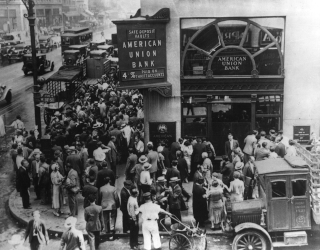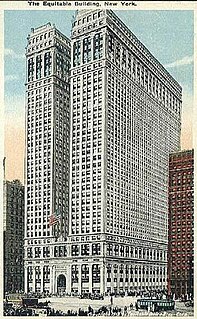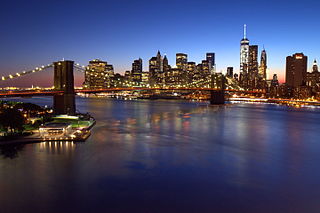
The Federal Deposit Insurance Corporation (FDIC) is a United States government corporation providing deposit insurance to depositors in U.S. commercial banks and savings institutions. The FDIC was created by the 1933 Banking Act, enacted during the Great Depression to restore trust in the American banking system. More than one-third of banks failed in the years before the FDIC's creation, and bank runs were common. The insurance limit was initially US$2,500 per ownership category, and this was increased several times over the years. Since the passage of the Dodd–Frank Wall Street Reform and Consumer Protection Act in 2011, the FDIC insures deposits in member banks up to US$250,000 per ownership category.
A capital gains tax (CGT) is a tax on capital gains, the profit realized on the sale of a non-inventory asset that was greater than the amount realized on the sale. The most common capital gains are realized from the sale of stocks, bonds, precious metals, and property. Not all countries implement a capital gains tax and most have different rates of taxation for individuals and corporations.

A bank run occurs when a large number of people withdraw their money from a bank, because they believe the bank may cease to function in the near future. In other words, it is when, in a fractional-reserve banking system, a large number of customers withdraw cash from deposit accounts with a financial institution at the same time because they believe that the financial institution is, or might become, insolvent; they keep the cash or transfer it into other assets, such as government bonds, precious metals or gemstones. When they transfer funds to another institution, it may be characterized as a capital flight. As a bank run progresses, it generates its own momentum: as more people withdraw cash, the likelihood of default increases, triggering further withdrawals. This can destabilize the bank to the point where it runs out of cash and thus faces sudden bankruptcy. To combat a bank run, a bank may limit how much cash each customer may withdraw, suspend withdrawals altogether, or promptly acquire more cash from other banks or from the central bank, besides other measures.
The savings and loan crisis of the 1980s and 1990s was the failure of 1,043 out of the 3,234 savings and loan associations in the United States from 1986 to 1995: the Federal Savings and Loan Insurance Corporation (FSLIC) closed or otherwise resolved 296 institutions from 1986 to 1989 and the Resolution Trust Corporation (RTC) closed or otherwise resolved 747 institutions from 1989 to 1995.
A money market fund is an open-ended mutual fund that invests in short-term debt securities such as US Treasury bills and commercial paper. Money market funds are widely regarded as being as safe as bank deposits yet providing a higher yield. Regulated in the United States under the Investment Company Act of 1940, money market funds are important providers of liquidity to financial intermediaries.
A bailout is a colloquial term for the provision of financial help to a corporation or country which otherwise would be on the brink of failure or bankruptcy.

Deposit insurance is a measure implemented in many countries to protect bank depositors, in full or in part, from losses caused by a bank's inability to pay its debts when due. Deposit insurance systems are one component of a financial system safety net that promotes financial stability.

The Financial Institutions Reform, Recovery, and Enforcement Act of 1989 (FIRREA), is a United States federal law enacted in the wake of the savings and loan crisis of the 1980s.

The Bank of United States, founded by Joseph S. Marcus in 1913 at 77 Delancey Street in New York City, was a New York City bank that failed in 1931. The bank run on its Bronx branch is said to have started the collapse of banking during the Great Depression.
IndyMac, a contraction of Independent National Mortgage Corporation, was an American bank based in California that failed in 2008 and was seized by the United States Federal Deposit Insurance Corporation (FDIC).

The Korea Deposit Insurance Corporation (KDIC) is a deposit insurance corporation, established in 1996 in South Korea to protect depositors and maintain the stability of the financial system. The main functions of KDIC are insurance management, risk surveillance, resolution, recovery, and investigation.
The Bank of Baltimore was a bank based in Baltimore, Maryland, that was chartered in 1795 and failed during the Panic of 1857. It was the seventh American bank to begin business in the United States and the second bank in Maryland.

The Freedman's Saving and Trust Company, popularly known as the Freedman's Savings Bank, was a private corporation chartered by the U.S. government to encourage and guide the economic development of the newly emancipated African-American communities in the post-Civil War period. Although functioning only between 1865 and 1874, the company achieved notable successes as a leading financial institution of African-Americans. However, its failure was devastating to the newly emancipated black community. Its archives are valuable as an exhaustive collection of information regarding the African American community and its socio-economic life in the immediate aftermath of emancipation.

The Philippine Deposit Insurance Corporation is a government-run Philippine deposit insurance fund. It was established on June 22, 1963 by Republic Act 3591. It guarantees deposits up to P500,000. Primary Functions of PDIC is to protect the small investors/depositors and to build a strong banking confidence.
Henry Bischoff & Company was a New York City banking house which became insolvent in January 1914. The business was started more than forty years prior to its failure by New York Supreme Court justice Henry Bischoff. From March 7, 1902 the bank was owned by Bischoff's son-in-law, James S. Meng and William J. Beacher, formerly Bischoff's partner. It was located at Tryon Row and Centre Street.
Consolidated National Bank of New York was a bank operating in New York City. Also referred to in the press as Consolidated National Bank, the institution was organized on July 1, 1902 with capital of $1 million. Wrote the New York Times, the bank was "founded with the idea of cornering the business of the Consolidated Exchange and its brokers." The bank opened for business at 57 Broadway on September 22, 1902, and a year later the bank took out a five-year lease at the Exchange Court Building. In 1906, the Consolidated Stock Exchange withdrew its deposits with the Consolidated National Bank. In 1909, the bank voted to acquire the assets of Oriental Bank and merge them with Consolidated, creating the National Reserve Bank. The Consolidated name was operative for a short time afterwards.
The National Reserve Bank of the City of New York was a bank in New York City that was formed from a merger of Consolidated National Bank and Oriental Bank in 1909. Deposits of the National Bank Reserve Bank were about $4,352,561 on January 13, 1914 and the bank had "a large number of country bank accounts, chiefly in the West and Southwest," handling a large degree of cotton exchange business. On January 27, 1914, the National Reserve Bank was taken over by the Mutual Alliance Trust Company, operating for a time as the Reserve Branch of the trust company.
The Rhode Island banking crisis took place in the early 1990s, when approximately a third of the state of Rhode Island's population lost access to funds in their bank accounts. When a Providence bank failed due to long-term embezzlement by its president, Joseph Mollicone, Jr., it triggered the collapse of the Rhode Island Share and Deposit Indemnity Corporation (RISDIC) and the subsequent closure of the 45 credit unions and banks it insured. 300,000 depositors lost access to their money. Though some of the institutions reopened relatively quickly after obtaining federal insurance, many could not and remained closed for an extended period of time. Though everyone was eventually repaid, most had to wait months or years for compensation.

The Continental Bank and Trust Company of New York was a financial institution based in New York City, New York, United States. It was established in 1870 as the German-American Bank, which became the Continental Bank of New York. Originally in the Equitable Building at 120 Broadway, the bank was later headquartered at 50 Wall Street, 25 Broad Street, and starting in 1932 the Continental Bank Building It became known as the “brokers bank” for its collaboration with Wall Street brokers and investment banking interests. The institution was renamed the Continental Bank and Trust Company of New York around 1929, at which point it was involved in extending its business with acquisitions of commercial banking and fiduciary operations. Acquired banks included the Fidelity Trust Company in 1929, International Trust Company and Straus National Bank and Trust Company in 1931, and Industrial National Bank later that year. In 1947, the bank earned $804,000 in net profits. As of December 31, 1947, Continental had total resources of $202,000,000, and deposits of $188,000,000. It merged with the Chemical Bank and Trust Company in 1948.












